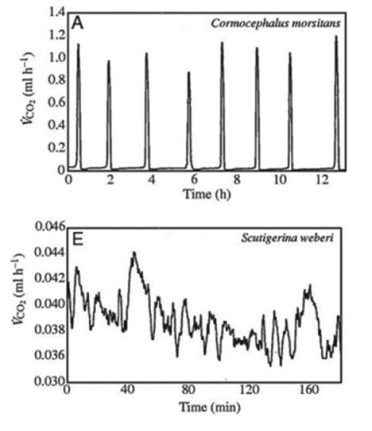Many terrestrial arthropods exchange gases with their environments by using tracheae, tubes that lead from openings (called spiracles) in the animal's exoskeleton or cuticle directly to the animal's tissues. Some arthropods can control whether their spiracles are opened or closed; opening the spiracles allows the carbon dioxide produced in the tissues to travel down the tracheae and be released outside the animal. Klok et al. measured the carbon dioxide emitted over time (represented by VCO₂) by several species of centipedes. The figures present graphs of their results for two species, Cormocephalus morsitans and Scutigerina weberi. (C. J. Klok, R. D. Mercer, and S. L. Chown. 2002. Discontinuous gas-exchange in centipedes and its convergent evolution in tracheated arthropods. Journal of Experimental Biology 205:1019-29.) Copyright 2002 The Company of Biologists and the Journal of Experimental Biology. 
Look at the graph for Scutigerina weberi (note the scale of the y-axis) in the figure.
- What is the best interpretation of these results?
Definitions:
Share-based Payment
Transactions in which an entity receives goods or services as consideration for its equity instruments or by incurring liabilities for amounts based on the price of the entity's shares.
AASB 2
The Australian Accounting Standards Board standard that specifies the financial reporting requirements for entities dealing with share-based payment transactions.
Incremental Fair Value
The additional value that is estimated to arise from a particular transaction or event over the current fair value of an asset or liability.
Share-based Payment
A way companies compensate employees or purchase goods and services by issuing shares of the company or options to buy shares, instead of cash.
Q9: A lateral root originates in the _.<br>A)
Q15: In the future, phylogenetic studies should be
Q31: Fungi have an extremely high surface-to-volume ratio.
Q32: Terry catches a ray-finned fish from the
Q44: The sharp, 2 centimetre-long thorns of the
Q45: Which of the following would inhibit the
Q55: The polarity of a plant is established
Q70: As you are walking along a beach,
Q74: Many terrestrial arthropods exchange gases with their
Q78: The presence of a lophophore in a